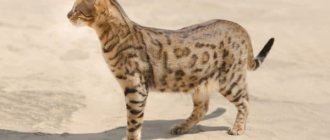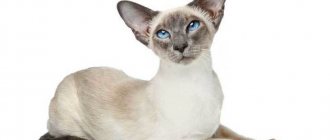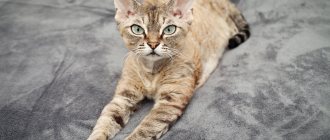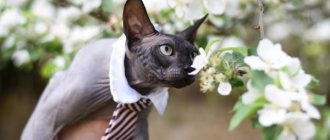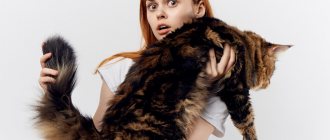Description of the Burmilla breed
Popularity 53rd place among 86 cat breeds
Lifespan:
18-19 years old
Height:
25-30 cm
Country of origin:
Great Britain
Average price:
35-40 thousand rubles
Weight:
4-7 kg
Latest articles Cat care
How to trim a cat's claws correctly and easily 01/28/2022 133 0 0
Dog health
How to do an ultrasound for dogs: preparation and procedure 01/28/2022 62 0 0
Photo and video
In the photos and videos in the gallery you can see in detail the appearance and habits of this beauty.
Photo:
Video:
Video: Burmilla all about the breed interesting facts
Video: Burmilla cat breed
Video: Burmilla. Breed characteristics, care
The Burmilla is a unique aristocratic breed that is suitable for both the elderly and the young, and even families with small children. At the same time, the cat does not require serious care. Leave your feedback about the breed. Are you happy that you live with a purebred cat?
Key facts
The official name of the breed is Burmilla. Because of its color, the cat is often called the Burmese silver.
According to the approved breed description, the Burmilla has a soft chinchilla-like coat. The most popular are those with short fur and low maintenance requirements. The cost of keeping long-haired cats is higher, but they are gradually winning the hearts of cat lovers with their spectacular appearance.
Key characteristics of the Burmilla breed include an easy-going nature. She is tactful and not pushy. Such pets are kind to children - in joint games they will protect the child from danger and will never bite him in response to a prank. Representatives of this breed are people-oriented. They are happy to keep company even with strangers.
The life expectancy of a Burmilla is 18-19 years. How long a cat lives depends on hereditary predisposition to diseases.
Care instructions
Burmillas know how to take care of themselves: sharpen their claws and lick their fur coat. But, if you want your cat’s beauty to blossom to the fullest, she cannot do without your help.
Wool
The pride of the Burmilla is its coat - it doesn’t matter whether it’s short or long, it requires weekly combing (long-haired Burmilla’s often develop tangles). Buy a special brush with natural bristles (or a mitten) and comb your pet, starting from the head and ending with the tail. This procedure will rid the cat of excess hair and skin secretions, and will also stimulate blood circulation.
Bathing
You should only bathe your Burmilla if the cat is very dirty. Representatives of this breed do not like water and are very nervous. Use only special cat shampoo, for example, Anju Beaute Cachemire Shampooing, Bio-Groom, Royal Groom.
There are also tint products on sale: Jerob Parisian Purple Shampoo for lilac and blue coat colors, Jerob Mahogony Gold Shampoo for brown coats. Human products are not suitable for animals, as they can cause allergies, skin dermatitis and poisoning.
Ears
Cats' ears accumulate wax and dirt over time. They should be cleaned weekly with a cotton swab soaked in ear lotion (Iv San Bernard, All Systems Ear So Fresh, Beaphar Oftal). A fresh decoction of chamomile is also suitable. You can’t pour anything into your ears!
Claws
It is up to the owner to decide whether to cut or clip their nails. Burmilla herself is capable of sharpening them well, and your task is to install a high-quality scratching post in a convenient corner.
Eyes
When fur gets on the mucous membrane of the eyes, it often causes irritation. This, in turn, provokes profuse tear production. Get into the habit of wiping your pet’s eyes every evening with a cotton pad soaked in tea leaves or chlorhexidine solution. Special products include Tsiprovet, Maxitrol, Ziver, and Cliny drops.
In the photo there is a long-haired Burmilla cat
History of the origin of the Burmilla
The country of origin of the breed is considered to be Great Britain, where in 1981 there was an accidental mating of two cats of different breeds. The owner of the unusual offspring was Baroness Miranda von Kirchberg, a famous breeder of Burmese and Persian cats. Due to the negligence of a servant, one of the Burmese was freed and met with a Persian. As a result of their short-term union, the Burmilla appeared.
Kirchberg was amazed by the gentle disposition and silvery hair of the newborns. She rushed to tell her friend Teresa Clark about the newborns. Having united, the women showed their discovery to geneticist Roy Robinson. The unusual kittens interested the scientist, who saw a bright future for them.
3 years later, in 1984, another offspring with greater variation in colors received the first standard from the felinological organization GCCF. In the same year, thanks to Clarke’s efforts, the first club of fans of the new breed appeared.
Soon, some of the Burmilla kittens came to Denmark, causing great delight on the part of local breeders. From that moment on, the Scandinavian line began its development. Despite its growing popularity, international organizations were in no hurry to approve the breed. The CFA recognized it only in 2014. At the same time, breeding began in Russia.
The name of the breed was obtained by merging the names of the breeds of its progenitors. The combination of a Burmese and Persian cat did not give a euphonious name, so the name of his chinchilla color was borrowed from his furry father.
What does a Burmilla look like?
In the photo of the Burmilla you can see one of its key features - its eyes, outlined with black edging. They look as if someone deliberately tinted them with eyeliner to make them even more expressive.
Representatives of this breed have weak sexual dimorphism. The sizes of girls are not much inferior to boys. On average, animals weigh 4-8 kg, and their height at the withers is 25-30 cm.
Muzzle
The breed is characterized by a medium-sized head with a blunt wedge shape. The short, rounded muzzle has plump cheeks. In males they are always larger. The width of the skull gradually tapers off from the forehead to the chin.
The contour of the muzzle is harmoniously continued by widely set ears. They are slightly inclined forward and rounded at the tips. When examining the profile, a clear stop is noticeable. The cat's nose, like its eyes, is framed with a black outline.
Expressive large eyes are no less widely set. The curved line of the upper eyelid gives it a similarity to oriental breeds, but the lower eyelid is curved into a smooth crescent. Amber and green iris colors are allowed. Kittens have a more reddish hue. It approaches the standard soon after maturity.
Body type
The cat's body is compact and muscular. Despite her strong bones, she looks very elegant and even a little fragile, but this impression is wrong. The wide chest is well defined, and a small hump of wool is clearly visible at the withers. The length of the shoulders and hips is the same.
The hind limbs are longer than the forelimbs. Their muscles are well developed. The rounded paws are equipped with black pads. The movable tail is of medium length and gradually tapers to a rounded tip.
Coat and color
The standard allows two varieties of Burmilla: smooth-haired and long-haired. Both species have soft, smooth and silky fur. Its hairs are colored zonally, that is, the color of the undercoat and the awn are different.
The color of the Burmilla can be shaded, solid, smoky or brindle. The color of the hairs on the back is always darker than on the belly. The undercoat is colored silver or gold, and the guard hair has many more options:
- chocolate;
- cream;
- lilac;
- brown;
- blue (gray).
Due to the different pigmentation of the hairs, the coat has a characteristic shine. Cats inherited this feature from the chinchilla Persian.
Appearance Features
The aristocratic origin of the graceful representatives of the breed is noticeable even in the look - intelligent and attentive. And the same can be said about other appearance features.
Burmilla has a sophisticated appearance
Burmillas are distinguished by an elegant, medium-sized body that ends in a long, thin tail. The weight of animals does not exceed 5–8 kg and does not depend on gender. The height at the withers of an adult pet ranges from 26–34 cm.
The breed standard also provides for other distinctive features of Burmillas:
- the head is gently rounded at the top and ends at the bottom with a wide, strong chin;
- protruding cheeks are very noticeable in cats, but in cats they have smoother outlines;
- the ears are spaced far apart and tilted forward;
- eyes wide open, almond-shaped;
- a dark line is drawn around the eye sockets, nose and lips;
- the nose is wide, has a clear bend at the base;
- iris color - amber, green or tortoiseshell;
- the limbs are spindle-shaped and have strong muscles.
The fur coat of purebred handsome dogs deserves special attention. At first glance, it seems that the white cat is covered with a thin transparent veil of black or brown color. It's all about the way the pigment is distributed in the villi. In Burmilla, based on this, two types of color are distinguished - tipped, when the hairs are 1/8 dark, and shaded. In the latter case, the hairs are darkened by 2/3 or 4/5 of the part. There is also a brindle variety of color and a solid one, when the fur coat has a uniform tint.
The range of colors among Burmillas is quite diverse and includes the following colors:
- brown;
- lilac;
- tortoiseshell;
- Bombay;
- brindle;
- chocolate;
- cream;
- speckled blue;
- speckled black;
- smoky.
A distinctive feature of the breed is the pure white coloring of the internal parts of the body - the chest, belly, chin, as well as the back of the paws and tail. At the same time, a dark woolen tubercle should protrude on the back of the neck.
Photo gallery: varieties of colors in Burmilla cats
Chocolate Burmilla cats resemble their ancestors, the Burmese cats.
The tortoiseshell color of the Burmilla is the most exotic of all.
The Burmilla's cream-colored coat is a very charming sight.
The speckled black color looks mysterious and unusual
The smoky coat color is characteristic of many representatives of the Burmilla breed.
The mottled blue Burmilla is a very popular cat breed.
If an animal is purchased not only as a simple pet, but also for participation in exhibitions, you need to become familiar with the defects of the breed. After all, shortcomings that appear during the breeding process do not allow winning prizes, and sometimes become the reason for refusal to register for competitions.
The disadvantages of the breed include:
- weakened lower jaw;
- uneven typing;
- brown or yellow shades on the coat;
- the appearance of tabby stripes in the presence of tipping or in a solid color.
The following are recognized as disqualifying characteristics for Burmilla:
- incorrect coloration of the iris in adults (after two years);
- oriental or cobby build (stocky, dense);
- tousled coat with elongated undercoat.
Video: Burmilla cat Max
Burmilla character
The sociable nature of the Burmilla and its “talkativeness” help to find quick contact with humans and other pets. Despite the fact that the cat loves to sit in the arms, she never imposes herself and chooses a time convenient for the owner.
If people pay attention to her, then the pet happily demonstrates her violent flow of emotions. She is not afraid of strangers and confidently greets them at the door.
The cat often suppresses its activity so as not to cause trouble to its owners. If you or your child takes the initiative on your own, she will happily support it. When playing with children, the chinchilla pet is very reserved and careful. Only she herself can suffer, since an attack on her little owner is taboo for her.
The cat's friendliness even extends to dogs. When communicating with other four-legged animals, she tries to show her superiority, she may become jealous, but she will never show open aggression.
Due to its intolerant attitude towards loneliness, the breed is suitable for those who have a lot of free time. You should not get this cat if you are a workaholic and rarely appear at home. Lack of attention has a detrimental effect on her psyche, so it is better to choose a different breed.
These animals have high intelligence. They quickly figure out how to open the kitchen cabinet and get to the food. The only downside is that a developed mind is combined with curiosity. On a walk, a pet can easily get lost if it gets carried away by something interesting.
Advantages and disadvantages
- High intelligence.
- Strongly attached to the owner.
- Friendly character.
- Affectionate.
- Moderately sociable.
- Good health.
- Non-aggressive.
- They are clean and take good care of their coat.
- They don't like to play and sleep a lot.
- They are not willing to make contact with strangers.
- They don't really like small children (but they don't show aggression).
- They leave a lot of fur when they shed.
- Allergenic.
- They don’t like water, and therefore don’t like swimming.
- They do not make contact with other animals; they prefer to hide or simply ignore them.
Raising a Burmilla
The basics of parenting are laid down by the mother, so it is very important not to take the baby away too early. She shows her kittens how to properly groom themselves, which makes training much easier in the future. Animals adopted through the nursery are already accustomed to the tray and scratching post, so they very quickly find their way around a new place.
Training a Burmilla cat is based on mutual respect. Do not try to put pressure on your pet or try to threaten it. A good result is achieved only when the animal performs actions of its own free will.
To wean yourself from unwanted actions, use auxiliary tools: newspaper, spray bottle and your voice. If your pet persistently chews and scratches everything that moves, gently hit him with a rolled-up newspaper, spray him with water, or simply demonstrate your indignation. Do not shout or hit the animal, so as not to cause the opposite effect. An offended or frightened cat may begin to go to the toilet past the litter tray out of revenge or fear.
Trained pets can learn simple tricks. They quickly remember their nickname and are happy to bring toys. These simple commands evoke pleasant associations, since the animal receives affection and approval from the owner for its efforts.
Burmilla health
With proper care, Burmilla health problems occur very rarely. Most of their diseases are hereditary, so when choosing a kitten, be sure to read the information about the parents.
To build a strong immune system, make sure you have enough vitamins. Typically, mineral and vitamin complexes are prescribed by a veterinarian, based on the tests of a mustachioed patient. They will have to be taken annually, since less frequent visits are fraught with late detection of hidden pathologies.
It is also important to remember about vaccinations. A vaccine is the only effective way to protect against viral infections. They promote the formation of an immune response and prevent infection.
Possible diseases
Artificially bred breeds are more vulnerable than native ones. The poor Burmillas inherited Persian polycystic kidney disease. Its appearance can be recognized by the following symptoms:
- frequent trips to the toilet;
- loss of appetite;
- sudden weight loss;
- lethargy and lethargy.
If such symptoms appear, consult a doctor immediately. Numerous cysts on the kidneys impair the functionality of the organ and can lead to kidney failure.
Another possible pathology is congenital keratoconjunctivitis, that is, inflammation of the cornea and conjunctiva. Due to the desiccation of the stratum corneum, the patient often develops vascularization, when blood vessels grow into the corneal tissue.
Males may develop orofacial pain syndrome. This disease has been little studied, so its exact cause is still unknown. Symptoms of the pathology include intense lip licking and constant chewing movements.
Animals are also vulnerable to allergies. To avoid an allergic reaction, never smoke around your pet and hide household chemicals in inaccessible places. If you experience a runny nose, watery eyes, red eyes, itching or rash, consult your doctor. The patient's condition is normalized with the help of individually selected antihistamines.
Reproductive health
The small number of representatives greatly complicates breeding. You can wait years for a purebred mating partner. If you cheat and try to act by analogy with the founder of the breed, then animals that meet the standard will appear only in the sixth generation. Because of this, matings between Burmese and chinchillas are practically not carried out.
The birth of offspring is planned no earlier than the third heat. Pregnancy lasts about 9 weeks, and the moment of birth is calculated individually. To get healthy kittens, it is important to carefully study the pedigree of your partner and examine your own pet.
Pet class animals are not allowed for breeding. Such pets undergo castration or sterilization, which eliminates reproductive function. Surgery may also be required for more elite representatives if their owner does not intend to raise kittens.
Diseases
Although this breed is distinguished by excellent health and strong immunity, there are still a number of diseases that cripple these furry beauties.
Here are the most common ones in veterinary practice:
- polycystic kidney disease;
- allergic reactions;
- dry keratoconjunctivitis;
- orofacial pain syndrome.
To prevent the development of diseases in a four-legged family member, proper care and monitoring of the pet’s behavior is necessary.
If you have any suspicions, you should make an appointment with your veterinarian as soon as possible.
Features of feeding and diet
Balance in the diet is important. Too few nutrients can lead to health problems, and too much food can lead to obesity. An adult pet is fed twice a day, giving no more than 150-200 g at a time. Up to 1 year, frequency and portions depend on age:
- newborns - mother's milk on demand;
- from 2 to 3 months – 5-6 times a day, but not more than 120-160 g per day;
- from 3 to 4 months – 4 times a day, 200-240 g per day;
- from 4 months to one year – 3 times a day, 250 g per day.
Try to feed in a certain place and do not give in to nighttime provocations. This will help wean the animal from begging and serenading you while you sleep. Also, adherence to the regime has a beneficial effect on the digestive tract.
When eating natural foods, use lean meat and poultry. Serve them along with cereals and vegetables. For a shiny coat and smooth bowel function, include fermented milk products in your menu.
Suitable vegetables include beets, zucchini, carrots and pumpkin. You will have to avoid tomatoes and eggplants, as they often cause diarrhea. Grapes and raisins are also prohibited. They can lead to acute poisoning.
For simplicity, you can use ready-made food. All norms are indicated on the packaging, which makes it easier to calculate portions based on the age and weight of the pet. Opt for quality products. Economy class food has low energy value and questionable ingredients. Not only will they not satiate the cat, but they can also provoke a number of diseases in him.
How to choose and where to buy a kitten
There are special breed nurseries in some large cities of our country - we note at the same time that this breed in Russia is currently not very widespread.
When conducting transactions of this kind, it is mandatory to have a purchase and sale agreement, a passport of the future pet with a pedigree, veterinary certificates of vaccination and vaccinations and other related documents.
Ideally, the choice of a child should be made in the presence of a specialist, at the age of 10 - 12 weeks of age, and the baby itself should be clean and well-groomed, without bald spots and other defects, the possible presence of which the breeder is simply obliged to warn the potential buyer.
Nurseries
Currently, only one nursery specializing in the reproduction and breeding of Burmilla cats is registered on the World Cat Federation website - Chatburdeoa, located in the city of Serpukhov, Moscow region.
Breed cost
It all depends on where the child was purchased - in a club or nursery the price will be noticeably higher than from a private breeder. For some individuals with a pedigree, but without any exhibition prospects, they may ask for 30,000 rubles.
Care and maintenance
Care and maintenance of the Burmilla differs slightly depending on the length of its coat. For short-haired dogs, it is enough to brush them once a week, while for long-haired dogs you will have to spend 3 times more time. Also, the frequency of brushing will have to be increased during shedding. This is necessary to prevent tangles.
In addition to grooming, don't forget about:
- Nail trimming. This procedure will not be necessary only for those who have free access to the street.
- Cleaning the ears, eyes and mouth. The cat should be cleaned daily to remove eye discharge that accumulates after sleep. The ears are quite small, so they accumulate dust and dirt for a long time. To keep them clean and healthy, monthly treatment with a special lotion, vegetable oil or plain water is sufficient. Like your ears, you will have to brush your teeth once a month. This will prevent the formation of plaque and caries.
- The washing up. Bathing is carried out only when dirty. Pets living at home are washed less often. To maintain the quality of the coat, veterinary shampoos designed for short-haired or long-haired cats are used.
Accustom your animal to grooming from childhood. Cats really do not like any procedures that limit their freedom. If you have never bathed your pet during the first two years of its life, then you can rest assured that the procedure will end in psychological trauma for the cat and physical trauma for you.
Vaccinations and antiparasitic treatment
Even exclusively kept at home is not a guarantee that the Burmilla will not become a victim of viral or infectious diseases. Therefore, for the purpose of prevention, the cat is subjected to routine vaccination against rhinotracheitis, calcivirosis and panleukopenia.
The first Burmese silver vaccination is given at the age of 7-8 weeks. After 28 days, the kitten is vaccinated again, but with an anti-rabies component. In the future, the Burmese silver is vaccinated once a year.
To prevent diseases transmitted by fleas and worms, the cat is systematically subjected to antiparasitic treatment. Medicines for Burmese silverback helminths are given twice a year with mandatory repetition after 10-14 days. To combat external parasites, collars, drops and shampoos are used.
Tips for choosing a kitten
It is better to buy Burmilla kittens only from licensed establishments. If you don’t know how to choose a purebred animal and not run into a mestizo, then stick to this option and don’t try to save money.
Nursery employees often provide free consultations to future owners, showing documents for kittens and their parents. After meeting the kids, you can easily make a choice, since their health is confirmed by the presence of a veterinary passport. The presence of sick animals is permissible only if they are isolated in a separate room and are not put up for sale.
Feeding the cat
For proper development and good health, the Burmilla needs adequate nutrition. It is most convenient to feed such a cat with premium or super premium dry food. When choosing food, you should pay attention to the following brands:
- Farmina;
- Pronature;
- Grandorf;
- Brit Care.
All of them meet international quality standards and do not contain questionable additives.
With a natural type of nutrition, sources of animal protein should predominate in the Burmilla’s diet. In addition to meat, the cat is given:
- porridge;
- offal;
- vegetables;
- ocean fish;
- eggs;
- sour milk.
In order not to harm the health of the Burmilla, pork, baked goods, sweets, smoked meats and sausages are excluded from its diet. Also, the cat is not given fresh milk, exotic fruits, bones, river fish or any food from the owner’s table.
